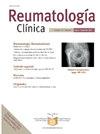智利类风湿关节炎患者一线生物和靶向合成疾病改善抗风湿药物的生存期
IF 1.3
Q4 RHEUMATOLOGY
引用次数: 0
摘要
在智利,难治性类风湿关节炎(RA)患者是生物和靶向合成疾病修饰抗风湿药物(b/tsDMARDs)治疗的候选者。由于目前可用于治疗类风湿性关节炎的药物的成本和多样性,更需要评估它们在现实世界中的生存期,主要是提供地方和国家数据。目的了解Copiapó地区医院风湿科门诊活动性难治性RA患者b/ tsdmard一线停药/改变的生存期及原因。材料和方法纳入b/tsDMARDs一线治疗的难治性RA患者。数据来自2018年1月1日至2023年7月31日期间RA患者的注册表,并通过查看医疗记录获得。描述了患者的人口统计学和临床特征,b/tsDMARDs的生存以及停药/改变治疗的原因。Kaplan-Meier图和log-rank检验。采用Cox模型确定影响停药的因素。结果130例患者符合入选标准。计算不同治疗的生存期,不包括利妥昔单抗和托珠单抗,因为n <;10。抗肿瘤坏死因子组、阿巴接受组、托法替尼组的生存率差异无统计学意义,p > 0.05。b/tsDMARDs的平均生存时间为194周。在该队列中,34.62% (n = 45)的患者停药/改变治疗,80%的患者缺乏疗效。结论在这组RA患者中,b/tsDMARDs一线治疗后的生存率无统计学差异。初始治疗的选择将取决于多种临床、人口、经济和监管因素。本文章由计算机程序翻译,如有差异,请以英文原文为准。
Survival of first line biological and targeted synthetic disease-modifying anti-rheumatic drugs in patients with rheumatoid arthritis in Chile
Introduction
In Chile, patients with refractory rheumatoid arthritis (RA) are candidates for treatment with biologic and targeted synthetic disease-modifying anti-rheumatic drugs (b/tsDMARDs). Due to the cost and diversity of drugs currently available to treat RA, there is a greater need to evaluate their survival in the real world and mainly to provide local and national data.
Objectives
To describe the survival and cause of discontinuation/change of first line b/tsDMARDs in patients with active refractory RA at the rheumatology clinic of the Regional Hospital of Copiapó.
Materials and methods
Patients with refractory RA on first-line treatment with b/tsDMARDs were included. Data were obtained from the RA registry of patients from January 01, 2018, until July 31, 2023, and by reviewing medical records. Demographic and clinical characteristics of the patients, survival of b/tsDMARDs, and cause of discontinuation/change of therapy are described. Kaplan–Meier plots and log-rank tests were performed. Cox model was used to identify factors that affected treatment discontinuation.
Results
One hundred thirty patients met the selection criteria. Survival of the different treatments was calculated, excluding rituximab and tocilizumab due to n <10. There were no significant differences between the survival of the groups (anti-TNF, abatacept, tofacitinib), with p > 0.05. The mean survival time for b/tsDMARDs was 194 weeks. In this cohort, 34.62% (n = 45) of the patients had treatment discontinuation/change, with lack of efficacy representing 80%.
Conclusion
In this cohort of patients with RA, there were no statistically significant differences in survival after first-line treatment with b/tsDMARDs. The choice of initial therapy will depend on multiple clinical, demographic, economic and regulatory factors.
求助全文
通过发布文献求助,成功后即可免费获取论文全文。
去求助
来源期刊

Reumatologia Clinica
RHEUMATOLOGY-
CiteScore
2.40
自引率
6.70%
发文量
105
审稿时长
54 days
期刊介绍:
Una gran revista para cubrir eficazmente las necesidades de conocimientos en una patología de etiología, expresividad clínica y tratamiento tan amplios. Además es La Publicación Oficial de la Sociedad Española de Reumatología y del Colegio Mexicano de Reumatología y está incluida en los más prestigiosos índices de referencia en medicina.
 求助内容:
求助内容: 应助结果提醒方式:
应助结果提醒方式:


